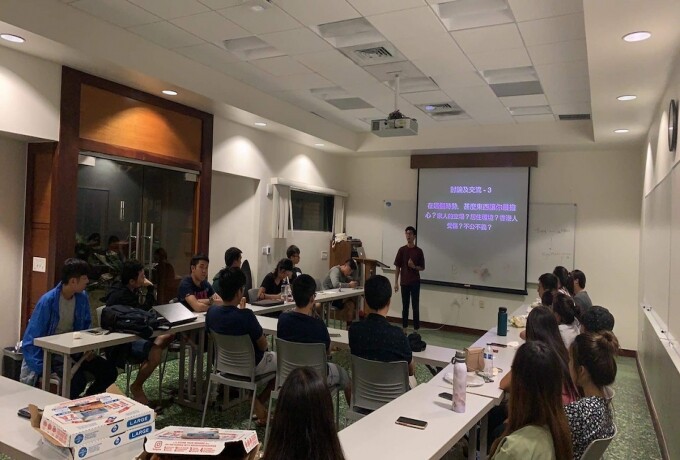
“Find calmness at the center of the hurricane” was the theme for Adrian Chan’s senior workshop where more than 25 students from Hong Kong came together on Nov. 15 in the McKay Foyer. Chan taught how a peaceful mindset is the key to building relationships and seeking change. Using Gandhi and Martin Luther King Jr. as historic examples, Chan also answered questions on how to overcome hostility and defend one's beliefs peacefully.
Chan, a senior from Hong Kong majoring in peacebuilding, said an interesting natural phenomenon is the center of a hurricane. Specifically, the eye of the storm because it is calm.
Chan said he gained his influence from that concept when he decided the goal of his workshop, which was to work with individuals to help them find calmness in the midst of the commotion of the Hong Kong protests.
He shared he also hoped this would lead them to be good influences to their friends, families, and communities, especially in difficult times.
Alex Yeung, a sophomore from Hong Kong majoring in hospitality and tourism management, said he felt relieved after Chan’s workshop. He said he learned making arguments with the opposite side is not useful because people can’t change anyone’s mind.
“Chan helped us to think more positively. When we are an example to use a peaceful way to show our demands, others will recognize and support the right.”
Agreeing with Yeung, Ivan Tang, a junior from Hong Kong majoring in computer science, said the workshop was inspiring and provided another angle to think on the same matter. “It is a good [platform] to let people express their feelings. They can be healed by expressing their emotion.”
The issue in Hong Kong
The workshop started off with a timeline of the entire movement from February to the present. According to Chan, the Hong Kong protests began after a Hong Kong citizen committed murder in Taiwan and escaped back to Hong Kong. When China intervened in an attempt to extradite the citizen, the situation exposed an incomplete law system across different countries, causing opposition and protests.
Yeung said the timeline recap helped him understand the entire movement, but it also led him to ponder why the Hong Kong protests changed from a peaceful march to the violent confrontations they are now.
Chan quoted from Gandhi, “If you want to take revenge and feed your hate, you will never be satisfied. Only love can eradicate hate, not hate by self.”
Yeung said his favorite story of the night was how Gandhi used nonviolence as a way to save Indians from the British government. Yeung said this example got him thinking about the importance of controlling our emotions. “I have no desire to [get] revenge by using violence. I know, as a member of the Church, we should treat everyone equally because they are also children of God.”
Chan introduced a pyramid he created for his workshop called the Influence Pyramid. The pyramid had five parts, but the entire foundation depended on a person’s desire to improve their mindset. As the pyramid ascended, it invited others to build relationships, listen and learn, communicate, then finally correct things that go wrong.
With the pyramid, Chan was able to share how messages will be less successful if protesters only try to make change without considering their mindset and relationship with others, especially others with influence.
Tang said after Chan explained the theory of the Influence Pyramid he learned people can sort things out in a better and more appropriate way when it comes to human relationships.
Chan shared he believes inner peace is necessary. He explained he was inspired by Martin Luther King Jr.’s quote, “Peace is not when the summer sky is clear and the sun shines in scintillating beauty. The peace of which Paul spoke is a calmness of soul amid terrors of trouble, inner tranquility amid the howl and rage of the outer storm, the serene quiet at the center of a hurricane amid the howling and jostling winds."
Chan’s workshop also included some questions on display, and he provided answers by discussing theories and famous stories from civil rights leaders such as Gandhi and Martin Luther King Jr. to respond to each topic in an academic way.
1. What would you answer when others ask where you stand?
Chan used a theory called “self-differentiation,” which means how much a person is affected by other’s opinions. Someone with low self-differentiation will be easily affected by others, while someone with high self-differentiation will not be easily affected. Chan said nothing is better than being yourself and expressing your opinions freely.
2. How would you react when others have a different opinion than you, even an offensive opinion?
Using a picture of a shoe and shoelace, Chan asked the audience, “What color do people see? Pink and white? Grey and green?" Chan explained how the picture meant a lot to him because he is slightly colorblind.
He said he wanted people to understand how everyone had the ability to see things differently. Similarly, a message may be heard by everyone differently. He shared how everyone has their own way to interpret information. For this reason, it is important for people to try to be understanding and maintain a peaceful mindset.
3. What can students do for Hong Kong while studying at BYUH?
Chan responded students can peacefully campaign along with fast and prayer.
4: As a Church member, what can you learn?
Chan invited students to love their enemy and said Martin Luther King Jr., another influential hero at promoting racial justice, used love to emphasize the gospel.
